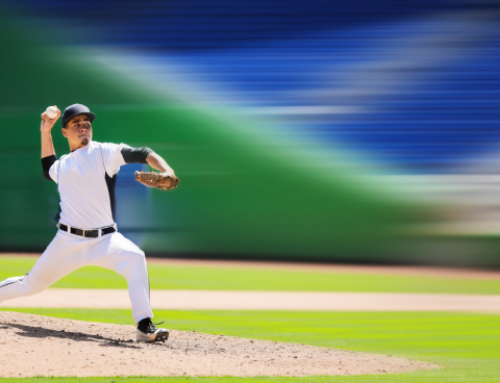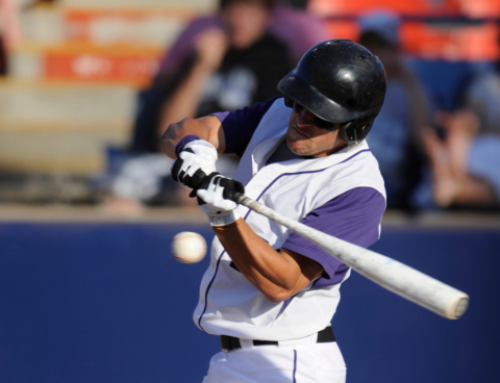Washington Nationals Exec Reveals What Pro Scouts Look for in Young Baseball Players
![]()
The competition among baseball players is fierce. It’s no secret that athletes need every edge they can get to make it to the next level.
Talk to any scout or anyone else responsible for Major League rosters, however, and you’ll learn that it’s not just skill development and training that matter. Athletes need to improve their abilities intelligently to become players that scouts and coaches will notice.
To help you become an elite baseball player, I interviewed Jeff Zona Sr., Washington Nationals special assistant to the general manager, who also happens to be my father. He provided insight into the qualities that pro scouts look for in up-and-coming baseball players—qualities that include some things you might never expect. Here’s what he had to say.
Q: What do MLB scouts look for in a high school or college pitching prospect’s physical build?
Ideally you want to see a tall frame that is filled out — think Roger Clemens, Curt Schilling or Clayton Kershaw. That type of build.
Q: What is an ideal build for a pitching prospect who is under six feet tall?
A strong body that can endure the innings of a starting pitcher. You want him to have a strong lower body especially.
Q: What things in a pitcher’s motion can scare scouts away?
The main scare is the high elbow in the back (inverted w), or a deep stab in the back with the throwing arm, because it makes it hard to get overtop of the breaking ball with consistency. The landing of the front leg is another one. You want your front leg to be firm, like a gymnast sticking a landing. Scouts do not want to see a guy land on his heel and spin off of it.
Q: What do you look for in a curveball?
Ideally you want a hard 12 to 6 breaking curveball that the pitcher can keep in the zone.
Q: What do you look for in a slider?
The slider is a pitch that varies from pitcher to pitcher. In today’s game, the slider and cutter are effective pitches that blend in and give a similar look. The slider should be tight and change planes and get into the lower zone. The cutter can stay flat across the zone (east-west break) and stay off the barrel of the bat.
Q: What do you look for in a change-up?
You want it around 10 mph slower than the fastball. Some pitchers have fade on their change-up, which means it fades away from the hitter. Some guys’ change-ups have a splitter-type drop. A lot of left-handed pitchers have change-ups that fade more than they drop.
Q: What do you look for in an outfielder’s arm?
You look for arm strength with accuracy. The best arm on the team should be in right field.
Q: What do you look for in a shortstop’s or third baseman’s arm?
Players at both positions should have a good arm on them. The shortstop should be able to go into the hole and throw a guy out. A third baseman should be able to field a ball overtop or behind the bag and still be able to throw the runner out.
Q: What do you look for in a second baseman’s arm?
At second, you can get away with having a below-average arm if you can still turn a double play and field well.
Q: What do you look for in a catcher’s arm?
A catcher’s arm has to be an above-average major league arm. Once the pro workload hits them and their body gets worn down during the season, they will lose some arm strength. If they have a cannon arm when they get drafted, once the workload hits them, they still stand a chance of having a major league-caliber arm. The other big thing is accuracy. A lot of times a guy who is accurate can throw more runners out than a guy who has better pop time but is less accurate.
Q: How much has velocity increased over your 26 years of scouting?
A lot.
Q: What has caused the velocity increase?
Players have become more specialized by not playing other sports and focusing strictly on increasing their velocity. Guys realized more velocity equaled more scholarships and more money in the draft. So guys got stronger and got more into weightlifting and just tried to run the gun up. And they did.
Q: What can young players do to reduce the arm injury epidemic?
There is no gauge, outside of simply using common sense and shutting it down when your arm isn’t feeling right. If that happens, go get it checked out. When you have thrown way too many innings and you know it, you need to have the common sense to stop throwing.
No one knows who is going to blow out and who isn’t. Some guys have clean deliveries and they blow out, while some guys like Chris Sale have violent mechanics and they don’t get hurt. Just do your exercises and stay away from overuse.
Q: When a player meets with a scout, how should he conduct himself?
Be yourself. Do not hide who you are.
Q: Should players worry about their on-the-field wardrobe?
Players should respect the game by having their shirt tucked in and things of that nature.
Q: How much background checking do scouts do?
It depends on which team the scout works for. Some teams make you do more background checks than others. Some scouts have their own individual ways of doing background checks.
Q: What are some ways scouts do background checks?
Some scouts go to the police station and check on the prospect’s criminal history. Checking social media is a big thing now. If you have something scandalous on social media, a team won’t draft you.
RELATED:
The 10 Best Exercises for Baseball Workouts
[cf]skyword_tracking_tag[/cf]RECOMMENDED FOR YOU
MOST POPULAR
Washington Nationals Exec Reveals What Pro Scouts Look for in Young Baseball Players
![]()
The competition among baseball players is fierce. It’s no secret that athletes need every edge they can get to make it to the next level.
Talk to any scout or anyone else responsible for Major League rosters, however, and you’ll learn that it’s not just skill development and training that matter. Athletes need to improve their abilities intelligently to become players that scouts and coaches will notice.
To help you become an elite baseball player, I interviewed Jeff Zona Sr., Washington Nationals special assistant to the general manager, who also happens to be my father. He provided insight into the qualities that pro scouts look for in up-and-coming baseball players—qualities that include some things you might never expect. Here’s what he had to say.
Q: What do MLB scouts look for in a high school or college pitching prospect’s physical build?
Ideally you want to see a tall frame that is filled out — think Roger Clemens, Curt Schilling or Clayton Kershaw. That type of build.
Q: What is an ideal build for a pitching prospect who is under six feet tall?
A strong body that can endure the innings of a starting pitcher. You want him to have a strong lower body especially.
Q: What things in a pitcher’s motion can scare scouts away?
The main scare is the high elbow in the back (inverted w), or a deep stab in the back with the throwing arm, because it makes it hard to get overtop of the breaking ball with consistency. The landing of the front leg is another one. You want your front leg to be firm, like a gymnast sticking a landing. Scouts do not want to see a guy land on his heel and spin off of it.
Q: What do you look for in a curveball?
Ideally you want a hard 12 to 6 breaking curveball that the pitcher can keep in the zone.
Q: What do you look for in a slider?
The slider is a pitch that varies from pitcher to pitcher. In today’s game, the slider and cutter are effective pitches that blend in and give a similar look. The slider should be tight and change planes and get into the lower zone. The cutter can stay flat across the zone (east-west break) and stay off the barrel of the bat.
Q: What do you look for in a change-up?
You want it around 10 mph slower than the fastball. Some pitchers have fade on their change-up, which means it fades away from the hitter. Some guys’ change-ups have a splitter-type drop. A lot of left-handed pitchers have change-ups that fade more than they drop.
Q: What do you look for in an outfielder’s arm?
You look for arm strength with accuracy. The best arm on the team should be in right field.
Q: What do you look for in a shortstop’s or third baseman’s arm?
Players at both positions should have a good arm on them. The shortstop should be able to go into the hole and throw a guy out. A third baseman should be able to field a ball overtop or behind the bag and still be able to throw the runner out.
Q: What do you look for in a second baseman’s arm?
At second, you can get away with having a below-average arm if you can still turn a double play and field well.
Q: What do you look for in a catcher’s arm?
A catcher’s arm has to be an above-average major league arm. Once the pro workload hits them and their body gets worn down during the season, they will lose some arm strength. If they have a cannon arm when they get drafted, once the workload hits them, they still stand a chance of having a major league-caliber arm. The other big thing is accuracy. A lot of times a guy who is accurate can throw more runners out than a guy who has better pop time but is less accurate.
Q: How much has velocity increased over your 26 years of scouting?
A lot.
Q: What has caused the velocity increase?
Players have become more specialized by not playing other sports and focusing strictly on increasing their velocity. Guys realized more velocity equaled more scholarships and more money in the draft. So guys got stronger and got more into weightlifting and just tried to run the gun up. And they did.
Q: What can young players do to reduce the arm injury epidemic?
There is no gauge, outside of simply using common sense and shutting it down when your arm isn’t feeling right. If that happens, go get it checked out. When you have thrown way too many innings and you know it, you need to have the common sense to stop throwing.
No one knows who is going to blow out and who isn’t. Some guys have clean deliveries and they blow out, while some guys like Chris Sale have violent mechanics and they don’t get hurt. Just do your exercises and stay away from overuse.
Q: When a player meets with a scout, how should he conduct himself?
Be yourself. Do not hide who you are.
Q: Should players worry about their on-the-field wardrobe?
Players should respect the game by having their shirt tucked in and things of that nature.
Q: How much background checking do scouts do?
It depends on which team the scout works for. Some teams make you do more background checks than others. Some scouts have their own individual ways of doing background checks.
Q: What are some ways scouts do background checks?
Some scouts go to the police station and check on the prospect’s criminal history. Checking social media is a big thing now. If you have something scandalous on social media, a team won’t draft you.
RELATED:
The 10 Best Exercises for Baseball Workouts
[cf]skyword_tracking_tag[/cf]










